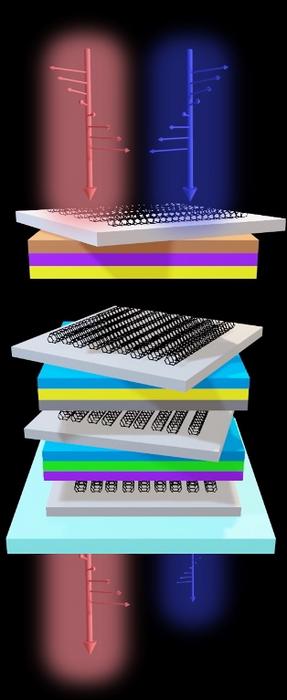In a groundbreaking development, researchers at the University of Utah have unveiled an innovative device designed to facilitate advanced optical computing by leveraging the properties of light. As traditional electronic systems remain constrained by their reliance on electricity, the potential for optical computing has garnered significant attention due to its ability to process data at unprecedented speeds. The crux of this research lies in a newly created heterostructure—a sophisticated construct made up of multiple thin films—capable of modulating the circular polarization of light in real-time.
This heterostructure incorporates aligned carbon nanotubes, which play a pivotal role in the manipulation of light. The unique arrangement and orientations of these nanotubes enable the device to function as both a chiral optical element and a transparent electrode. In doing so, the researchers have eliminated the need for additional control components traditionally necessary for optical systems, thus streamlining the architecture of optical circuitry. The underlying technology promises not only enhanced performance but also scalability, making it a promising candidate for next-generation optical systems.
Chiral light, characterized by its “handedness,” is a fundamental element in this research. The significance of chiral light stems from its ability to carry information through its rotational properties as it propagates through space. Left-handed and right-handed chiral light differ in structure, forming spirals that can be utilized to convey information more efficiently than conventional binary systems based on electricity. Professor Weilu Gao, alongside Ph.D. candidate Jichao Fan, articulated the constraints of traditional chiral optics, noting their limitation in real-time applications, which remain static and unyielding like “carved stone.” The new device, however, introduces versatility, enabling “living” optical matter that responds dynamically to electrical stimuli.
By employing a carbon nanotube-based heterostructure, the research team has effectively merged the realms of light manipulation and information storage. This device symbolizes a significant stride towards reconfigurable optical computing systems. It utilizes a phase-change material known as germanium-antimony-tellurium, known for its ability to undergo rapid changes from amorphous to crystalline states. This transition is crucial as it affects the structure of the material under applied electrical pulses, subsequently influencing the characteristics of the circular dichroism—a property integral to how it interacts with different types of circularly polarized light.
Fascinatingly, the capacitative switching function of the carbon nanotubes serves dual purposes. Not only do they govern the manipulation of light’s chirality, but they also facilitate the necessary phase changes in the underlying PCM layer. This dual functionality eradicates the requirement for separate control mechanisms, marking a significant optimization in the design and functionality of optical circuits. The device’s ability to fine-tune its circular dichroism—an optical characteristic that determines how it absorbs circularly polarized light—profoundly enhances the potential for memory storage in optical computing analogs.
The advancements made in manufacturing techniques, alongside the incorporation of artificial intelligence in design, played a critical role in the successful assembly of this heterostructure. The ability to maintain the optical integrity of each layer during the stacking process represents a notable achievement. This layered approach enables the device to effectively filter out specific circularly polarized light, enhancing its applicability for versatile optical operations while maintaining efficiency and speed.
Furthermore, the research holds implications far beyond mere data processing speed. The manipulation of circular dichroism introduces an orthogonal information channel, distinct from traditional parameters such as amplitude or wavelength. Researchers are now able to modify an independent parameter without interference from other characteristics of the light, thus expanding the methodologies available for data encoding and transmission in optical circuits. In an era where data transmission speed is paramount, this development marks a significant leap forward.
The transformative potential of this research resonates across various fields, including telecommunications, data centers, and beyond. Optics-based systems promise not only increased processing speeds but also reduced energy consumption compared to traditional electronic methods. As researchers delved deeper into the mechanics of light and materials, the integration of these findings into practical applications becomes an exciting frontier in scientific exploration.
The implications of this technology are profound, potentially reshaping how computational tasks are approached. With laser speeds and parallel data processing capabilities inherent in light, devices built on this technology could revolutionize computing by enabling massively parallel processing architectures. This newfound understanding of light manipulation empowers a new breed of scientists and engineers to explore uncharted territories in physics, materials science, and computational engineering.
Looking to the future, the University of Utah’s pioneering work in optical computing illustrates the potential for collaborative research to yield transformative results. As graduate students and faculty members continue to innovate, the prospects of practical applications bring the concept of optical computing closer to reality. The groundwork laid by this team may inspire further studies and developments that will ultimately lead to sophisticated optical devices capable of unprecedented computational efficiencies.
In the grand tapestry of technological advancement, the intersection of light and materials science is set to be a focal point of exploration. With the quickened pace of research and the amalgamation of multi-disciplinary insights, there is no telling how far the fields of optics and computing can advance. The journey toward a truly optical computing paradigm is still unfolding, and with each breakthrough like this, the potential for a brighter, faster, and more efficient future draws nearer.
The research was documented in a recent publication in the journal Nature Communications, positioned firmly within the contemporary discourse surrounding optical computing. This work, spearheaded by Professor Gao and his team, is not just an academic exercise but a beacon of innovation in science and technology, pointing toward a future where light is harnessed for the most complex of computational tasks.
Subject of Research: Development of a reconfigurable optical device for computing
Article Title: A Programmable Wafer-scale Chiroptical Heterostructure of Twisted Aligned Carbon Nanotubes and Phase Change Materials
News Publication Date: May 14, 2025
Web References: Nature Communications
References: DOI
Image Credits: University of Utah




